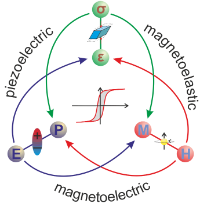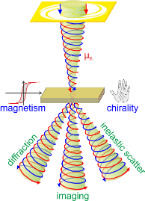Core to Core Research Themes
Chirality is ubiquitous and underpins our understanding of research fields as diverse as particle physics and molecular biology. It is the symmetry property of an object to exist as distinguishable left- and right-handed forms. Chirality also governs useful electronic and optical properties of many advanced materials. We target three broad themes, in which our individual expertise will be stimulated by fresh perspectives brought by the consortium.
- Atomic-scale electronic chirality and novel magnetic crystals.
 A simple manifestation of electronic chirality is the emergence of magnetism. The most fundamental electronic correlations in chiral crystals can give rise to a variety of magnetic orderings, of which only a small subset (skyrmions) have been recognised as potentially useful. Our insight is to study the largely overlooked area of helicoidal media, which have spiral arrangements of magnetic moments and are more robust and easier to realise than skyrmions. We will combine our expertise in chiral materials (Hiroshima) with internationally-leading electron microscopy of magnetic materials (Glasgow) and theory (Urals) to propel an exploration of artificially designed and naturally occurring helicoidal magnetic materials that have strong potential for applications utilising magnetoresistance and magneto-optical response.
A simple manifestation of electronic chirality is the emergence of magnetism. The most fundamental electronic correlations in chiral crystals can give rise to a variety of magnetic orderings, of which only a small subset (skyrmions) have been recognised as potentially useful. Our insight is to study the largely overlooked area of helicoidal media, which have spiral arrangements of magnetic moments and are more robust and easier to realise than skyrmions. We will combine our expertise in chiral materials (Hiroshima) with internationally-leading electron microscopy of magnetic materials (Glasgow) and theory (Urals) to propel an exploration of artificially designed and naturally occurring helicoidal magnetic materials that have strong potential for applications utilising magnetoresistance and magneto-optical response. - Micron-scale electronic chirality and chiral plasmonic metamaterials.
Plasmons - collective electronic excitations - can interact strongly with electromagnetic radiation, particularly in patterned metallic structures. We will explore chirally patterned media that we have already demonstrated to have a number of applications. For example, Glasgow has pioneered the use of such chiral plasmons as ultra-sensitive sensors for chiral biomolecules whilst Tokyo has expertise in the optical characterisation of such structures. A second application is the development of on-chip plasmonics to form the basis of a wide class of devices suitable for THz applications (Glasgow), which we will now augment by incorporating chiral patterned magnetic materials as reconfigurable components. These composite structures offer new possibilities for application as THz phase shifters or sensors for functionalised nanoparticles. - Chirally-sensitive electron probes.
 The study of chiral materials is eased by the development of chiral-specific techniques. Glasgow has long-standing expertise in the use of chiral photon probes in the context of optical orbital angular momentum for light beams whilst Monash has expertise in forming analogous electronic probes that would be suitable for chirally-specific electron microscopy. Prototypical measurements in the use of such vortex beams for imaging plasmonic structures and chiral spin textures are already underway (Hiroshima, Glasgow) and will be employed for the first time in the study of materials generated in both of the above themes.
The study of chiral materials is eased by the development of chiral-specific techniques. Glasgow has long-standing expertise in the use of chiral photon probes in the context of optical orbital angular momentum for light beams whilst Monash has expertise in forming analogous electronic probes that would be suitable for chirally-specific electron microscopy. Prototypical measurements in the use of such vortex beams for imaging plasmonic structures and chiral spin textures are already underway (Hiroshima, Glasgow) and will be employed for the first time in the study of materials generated in both of the above themes.

